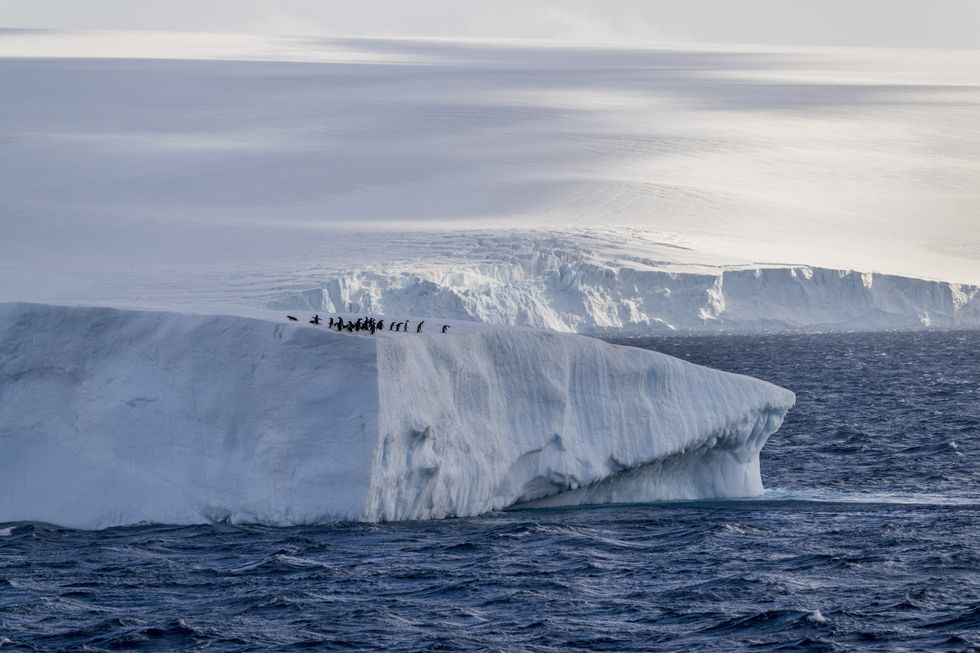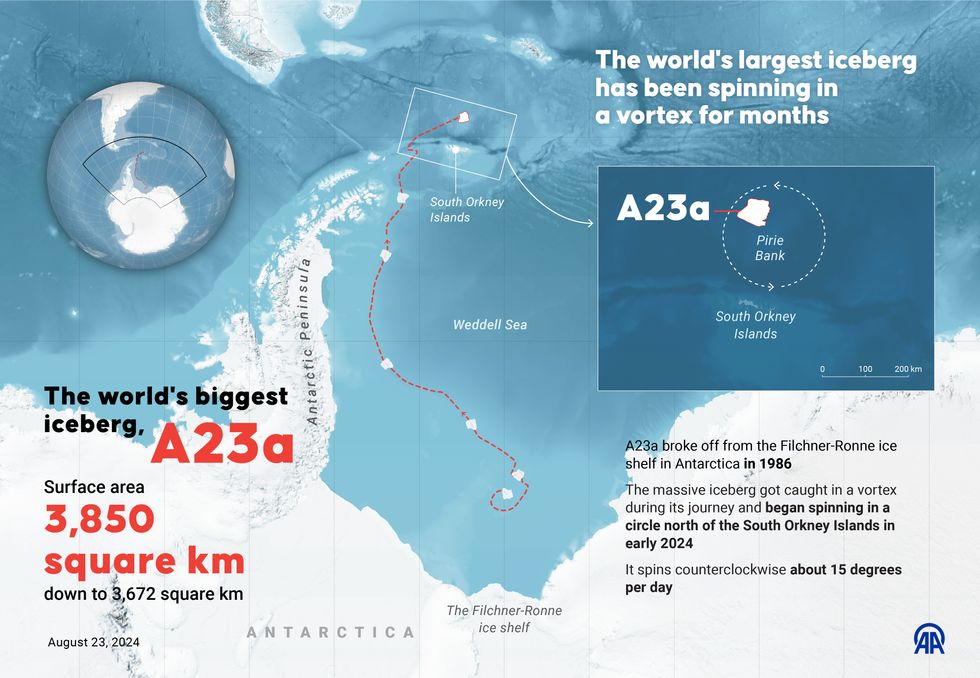The world's largest and oldest iceberg has finally broken free after being grounded for more than three decades, scientists have confirmed.
A23a - a colossal ice mass weighing nearly a trillion tonnes which weighs twice the size of Greater London - has begun drifting in the Southern Ocean.
The mega-berg, which had recently been spinning in place north of the South Orkney Islands, is now embarking on what experts believe will be its final journey.
The massive iceberg, measuring about 400 metres in thickness, had been caught in an oceanographic phenomenon known as a Taylor Column.

This peculiar situation, where rotating water above an underwater mountain trapped the berg, caused A23a to complete a full rotation every 24 days.
The iceberg's keel section, extending 350 metres below the waterline, had previously kept it anchored to the seafloor since its formation.
Since April, British Antarctic Survey scientists have been tracking the berg's movements using satellite imagery.
The iceberg originally broke away from Antarctica's Filchner Ice Shelf in 1986, at which time it was part of a larger formation known as A23.
At the time of calving, the ice mass contained a Soviet Union research centre which scientists were forced to abandon.
LATEST DEVELOPMENTS:
- Neanderthals and humans mated just 50,000 years ago, new research suggests
- Archaeology breakthrough as Cleopatra's 'true face' discovered in long-lost tomb
- Asteroid discovery hailed by scientists after vital breakthrough in 'planetary defence'
After breaking free, A23a remained grounded in the Weddell Sea for over three decades due to its massive underwater structure.
Then, by 2020, the iceberg finally began its slow journey northward, marking the start of its current movement.
Dr Andrew Meijers, an oceanographer with the British Antarctic Survey, expressed enthusiasm about the iceberg's movement, saying: "It's exciting to see A23a on the move again after periods of being stuck," he said.
"We are interested to see if it will take the same route the other large icebergs that have calved off Antarctica have taken," Meijers added.
Scientists have expected A23a to continue its journey into the Southern Ocean, following the powerful Antarctic Circumpolar Current.

This current is likely to drive the massive iceberg towards the sub-Antarctic island of South Georgia and, as it encounters warmer waters in this region, experts have predicted that A23a will begin to break up into smaller icebergs.
These fragments will eventually melt completely, marking the final chapter in the iceberg's decades-long journey.
Laura Taylor, a biogeochemist on the vessel, explained: "We know that these giant icebergs can provide nutrients to the waters they pass through, creating thriving ecosystems in otherwise less productive areas."
The research team collected water samples from various points around A23a's route to study its environmental effects.
"They should help us determine what life could form around A23a and how it impacts carbon in the ocean and its balance with the atmosphere," Taylor added.
from GB News https://ift.tt/1ezV0di
The world's largest and oldest iceberg has finally broken free after being grounded for more than three decades, scientists have confirmed.
A23a - a colossal ice mass weighing nearly a trillion tonnes which weighs twice the size of Greater London - has begun drifting in the Southern Ocean.
The mega-berg, which had recently been spinning in place north of the South Orkney Islands, is now embarking on what experts believe will be its final journey.
The massive iceberg, measuring about 400 metres in thickness, had been caught in an oceanographic phenomenon known as a Taylor Column.

This peculiar situation, where rotating water above an underwater mountain trapped the berg, caused A23a to complete a full rotation every 24 days.
The iceberg's keel section, extending 350 metres below the waterline, had previously kept it anchored to the seafloor since its formation.
Since April, British Antarctic Survey scientists have been tracking the berg's movements using satellite imagery.
The iceberg originally broke away from Antarctica's Filchner Ice Shelf in 1986, at which time it was part of a larger formation known as A23.
At the time of calving, the ice mass contained a Soviet Union research centre which scientists were forced to abandon.
LATEST DEVELOPMENTS:
- Neanderthals and humans mated just 50,000 years ago, new research suggests
- Archaeology breakthrough as Cleopatra's 'true face' discovered in long-lost tomb
- Asteroid discovery hailed by scientists after vital breakthrough in 'planetary defence'
After breaking free, A23a remained grounded in the Weddell Sea for over three decades due to its massive underwater structure.
Then, by 2020, the iceberg finally began its slow journey northward, marking the start of its current movement.
Dr Andrew Meijers, an oceanographer with the British Antarctic Survey, expressed enthusiasm about the iceberg's movement, saying: "It's exciting to see A23a on the move again after periods of being stuck," he said.
"We are interested to see if it will take the same route the other large icebergs that have calved off Antarctica have taken," Meijers added.
Scientists have expected A23a to continue its journey into the Southern Ocean, following the powerful Antarctic Circumpolar Current.

This current is likely to drive the massive iceberg towards the sub-Antarctic island of South Georgia and, as it encounters warmer waters in this region, experts have predicted that A23a will begin to break up into smaller icebergs.
These fragments will eventually melt completely, marking the final chapter in the iceberg's decades-long journey.
Laura Taylor, a biogeochemist on the vessel, explained: "We know that these giant icebergs can provide nutrients to the waters they pass through, creating thriving ecosystems in otherwise less productive areas."
The research team collected water samples from various points around A23a's route to study its environmental effects.
"They should help us determine what life could form around A23a and how it impacts carbon in the ocean and its balance with the atmosphere," Taylor added.




0 Comments
Don't share any link